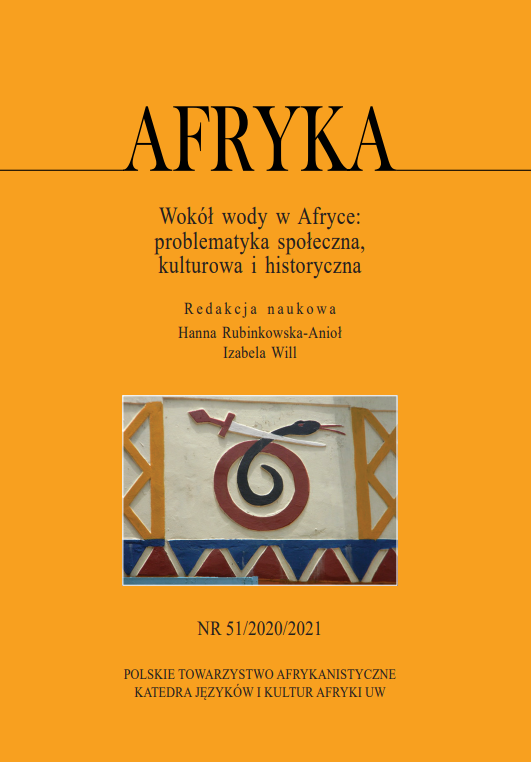The activities of Wangari Muta Maathai. Responsibility for nature and human rights from the perspectives of the Green Belt Movement
Published 2022-04-16
Keywords
- Wangari Muta Maathai,
- Kenya,
- water,
- trees,
- natural environment conservation
- protection,
- democracy,
- human rights ...More
Abstract
The article presents Wangari Muta Maathai’s lifetime achievements and her involvement in the environmental protection in Kenya (1977–2011). The analysis of the Green Belt Movement seeks answers to the questions concerning African grassroots movements and their opportunities in the field of natural environment conservation, including safe access to potable water sources. The organisation initiated by Wangari Muta Maathai has been promoting the idea of tree planting in order to maintain sustainable ecosystem, which also concerns the crucial issue of sufficient clean water resources. The main source book used in this article is Maathai’s autobiography that is supported by individual observations of Magdalena Dębowska, gained during numerous visits in Kenya in the following years: 2007, 2008, 2010, 2011–2012.
References
- Brooks C., Melanie. 2017. „Grassroots leadership for ecological sustainability, empowerment and political change. Wangari Maathai and the Green Belt Movement”, w: Jeffrey S. Brooks, Anthony H. Normore (red.), Leadership lessons: Great thinkers on equity, justice and education, New York: Teachers College Press, 14–22.
- Gulyani, Sumila; Debabrata Talukdar, Mukami R. Kariuki. 2005. „Water for the urban poor: water markets, household demand and service preferences in Kenya”, Water Supply and Sanitation Sector Board Discussion Paper Series 5, 1, The World Bank Group.
- Kirkscey, Russell. 2007. „Accommodating traditional African values and globalization: Narrative as argument in Wangari Maathai’s Nobel Prize Lecture”. Women and Language 30, 2.
- Maathai, Wangari. 2004. Nobel lecture, https://www.nobelprize.org/prizes/peace/2004/maathai/26050-wangari-maathai-nobel-lecture-2004/, dostęp z dnia 20 stycznia 2021.
- Maathai Muta, Wangari. 2006. Unbowed. One woman’s story. London: Arrow Books.
- Maathai Muta, Wangari. 2009. The challenge for Africa. London: Arrow Books.
- Maathai Muta, Wangari. 2020. Dr. Wangari Maathai plants a forest. Los Angeles: Rebel Girls.
- Marshall, Samantha. 2011. „The water crisis in Kenya: Causes, effects and solutions”, Global Majority E-Journal 2, 1, 31–45.
- Mumma, Albert. 2007. „Kenya’s new water law: an analysis of the implications of Kenya’s Water Act, 2002, for the rural poor”, w: B. van Koppen, M. Giordano, J. Butterworth (red.), Community-based water law and water resource management reform in developing countries, Oxfordshire: Cabi, 158–172.
- nobelprize.org. 2004. https://www.nobelprize.org/prizes/peace/2004/maathai/facts/, dostęp z dnia 15 lutego 2021.
- Ofcansky, Thomas P. 1984. „Kenya forestry under British Colonial Administration, 1895–1963)”. Journal of Forest History 28, 3, 136–143.
- Ogendi, George M.; Issac M. Ong’oa. 2009. „Water policy, accesibility and water ethics in Kenya”. Santa Clara Journal of International Law 1, 7, 177–196.
- Pawełczak, Marek. 2004. Kenia. Warszawa: Trio.
- Prévot, Franck; Aurélia Fronty. 2017. Wangari Maathai: The woman who planted millions of trees. Watertown: Charlesbridge.
- Rateb, Ashraf; Hermas ElSayeb. 2020. „The 2018 long rainy season in Kenya: Hydrological changes and correlated land subsidence”. Remote Sensing 12, 1–16.
- reliefweb. 2005. „Kenya: At least 14 killed in clashes over water”. https://reliefweb.int/report/kenya/kenya-least-14-killed-clashes-over-water, dostęp z dnia 23 stycznia 2021.
- Roy, L. Jessica; Ben Crow; Brent Swallow. 2005. „Getting access to adequate water: Community organizing, women and social change in Western Kenya”. International workshop on African Water Laws: Plural Legislative Frameworks for Rural Water Management
- in Africa, South Africa. https://dlc.dlib.indiana.edu/dlc/bitstream/handle/10535/5058/ROY-J.pdf?sequence=1, dostęp z dnia 23 stycznia 2021.
- Understanding the Kenia 2016 Water Act. 2016. „2030 Water Resources Group”. https://www.2030wrg.org/wp-content/uploads/2016/12/Understanding-the-Kenyan-Water-Act-2016.pdf, dostęp z dnia 19 stycznia 2021.
- [The] Water Act. 2016. Kenya Gazette Supplement 164. https://wra.go.ke/wp-content/uploads/2019/05/The_Water_Act_2016.pdf, dostęp z dnia 19 stycznia 2021.
- WASREB. 2020. https://wasreb.go.ke/national-water-services-strategy/, dostęp z dnia 15 lutego 2021.
- water.org. 2021. https://water.org/our-impact/where-we-work/kenya/, dostęp z dnia 18 stycznia 2021.
- WHO/UNICEF Joint Monitoring Report. 2019. https://www.unicef.org/kenya/water-sanitation-and-hygiene#:~:text=The%20WASH%20joint%20monitoring%20programme-for%20the%20survival%20of%20, dostęp z dnia 18 stycznia 2021.
- World Bank. 2004. Towards a water-secure Kenya: Water resources sector memorandum. Washington, DC. https://openknowledge.worldbank.org/handle/10986/15546 License: CC BY 3.0 IGO, dostęp z dnia 20 stycznia 2021.
